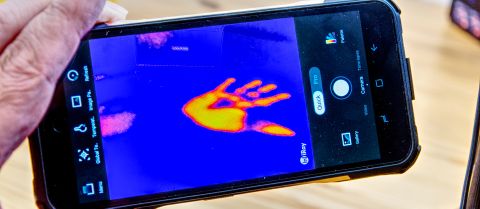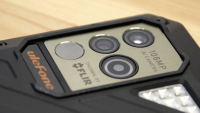TechRadar Verdict
Some minor enhancements over the V20, but essentially the same phone with the addition of thermal imaging. Shame they didn’t fix any of the issues with the original design in the Pro.
Pros
- +
Folding foot
- +
500nit OLED screen
- +
Thermal image camera
Cons
- -
No wireless charging
- -
Quoted thermal resolutions
Why you can trust TechRadar
30-second review
It’s easy to look at a phone range with a Pro and non-pro model and assume that the V20 Pro has slightly more RAM and maybe a marginally better camera.
When we reviewed the Doogee V20 in early 2022, it was a solid, rugged phone design with a few quirks, like a tiny screen on the back that showed a clock.
Although they share many aspects, like the battery size and the amount of storage, the V20 Pro has a radically different market in mind, with a few special features.
Where the V20 offers an infrared night vision camera with limited range, the V20 Pro has that and an InfiRay-powered thermal imaging scope. It can detect body heat up to 1000m away, allegedly, and at a resolution where you can determine what those glowing blobs are up to.
The quality of this thermal camera could make it invaluable for those working with engines or electronics, and its proximity to the rear optical cluster allows for hybrid captures.
There are also a few other desirable features, like a metal kickstand useful for watching streamed content or video conferencing.
Overall, the Doogee V20 Pro is, at best, a derivative of its predecessor, giving it a wider appeal to include those that need some of its unique features.
What it critically lacks is a top-rung processor, wireless charging or Widevine L1 encryption. It also isn’t especially cheap, but any phone with this feature set will be priced accordingly.
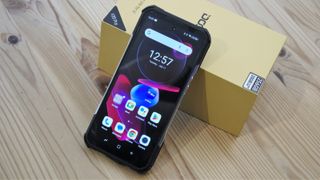
Doogee V20 Pro: price and availability
- How much does it cost? $569 /£499/€499
- When is it out? It is available now
- Where can you get it? You can get it in most regions direct from Doogee or from an online reseller such as Amazon.
Available in Black and Silver, the V20 Pro can be bought directly from Doogee online or from several online resellers, like Amazon.
Like many phone makers, Doogee likes to quote a price that they’ve reduced it from. Although we’ve no idea if it ever sold for $799, it's being offered for $569 at the time of this review.
For the UK and EU countries, the phone ships locally from those countries. But for the US and Mexico, and some smaller EU countries, it ships from Asia with a 2-8 day delivery timescale.
If you don’t mind a longer wait, it is also available from AliExpress, for just $389.06 (£319.23), for a global version.
The disparity between the direct cost and what it can be found for elsewhere is so significant that it begs the obvious question of what it costs Doogee to make?
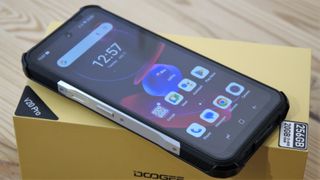
- Value score: 4/5
Doogee V20 Pro design
- Lightweight but rugged
- Limited charging options
- Facetime foot
The Doogee V20 Pro that was sent to us for review came with the following hardware:
CPU: Dimensity 700 MT6833 Octa Core 2.2GHz
GPU: ARM Mail-G57 MC2
RAM: 12GB LPDDR4X
Storage: 256GB
Screen: 6.43" AMOLED FHD+
Resolution: 1080 x 2400
SIM: Dual Nano with standby
Weight: 296g
Dimensions: 170.5 x 81.2 x 14mm
Rear camera: AI Triple camera (64MP+24MP+8MP) with Nightvision mode, Thermal sensor
Front camera: 16 MP
Thermal Imaging: InfiRay
OS: Android 12
Battery: Li-Po 6000mAh
Charging: 33W (wired only)
Rugged phones are starting to fragment into two general classifications: heavy designs with battery capacity being their key feature and lighter models with more general applications.
The V20 Pro, as did the V20, fits into the latter pigeonhole, providing all the signature impact, dust and water resistance in a package that’s not excessively heavier than a premium phone.
It’s large, has the angled rubberised corners we’ve come to expect, metal sides and has the now ubiquitous thumb activated (if you are right-handed) fingerprint sensor.
But at just 296g, the same as the V20, the V20 Pro is only 56g more than an iPhone 14 Pro Max (2022), and therefore much easier to hold and pocket than something like the 395g Doogee S100 Pro, as an example.
The chamfered sides of this phone make it pleasing to handle, and it's also easy to find all the metal buttons without looking specifically at them.
One of our pet hates is rubberised plugs over the USB-C port, and the V20 Pro has an annoying one on the bottom edge that refuses to move cleanly out of the way.
As the rear of the V20 Pro is remarkably flat, we held out hope that it might support wireless charging, but it doesn’t. And more disappointment, there aren’t any Pogo pins for a cradle charging option either.
There is, however, a couple of features on the back that are much better considered, and we’d like to see them on more phones.
The first is a camera cluster that avoids putting any sensors close to the sides and limits the amount that any stick out. A shallow wall encompasses the camera cluster, hopefully keeping the glass covering them from getting easily scratched.
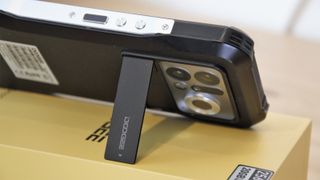
The second feature we liked most was a simple but effective metal stand that folds flat against the case. This extension is perfect for setting the phone at an angle for watching streamed content or Facetime activities. Our only reservation is that it can’t be used to support the phone for rear camera operations, such as time-lapse filming.
Despite not offering the full tripod experience, this extendable leg is a great feature, and we’d be glad to see it appear on future Doogee phones.
Overall, with the exception of the foot, the V20 Pro isn’t a design that strays far from the V20 playbook, at least on the surface.

Design score: 4/5
Doogee V20 Pro hardware
- Average platform
- More RAM
- RAM expansion tech
We’re not going to talk at length about the platform in the V20 Pro, as it is practically identical to that in the V20, and you can read that review here.
It’s built around the MediaTek Dimensity 700 MT6833, an eight-core chip fabricated on a 7nm process that Doogee engineers previously used in the V10.
A development from the MediaTek Helio P70 Octa-core processor, the MT6833 added an integrated 5G modem and changed the core structure into a 2-and-6 ratio of performance and efficiency from one where it was a four-by-four configuration.
One difference between the implementation in the V20 Pro over the V20 is that the memory has been bumped up from 8GB up to 12GB. It also incorporates what Doogee has rebranded as Memory Fusion, where the phone can allocate up to 8GB of storage as RAM increasing that available for apps to 20GB.
You’d need to be obsessive to fill 12GB with apps, but for those that like icons, this phone supports even more.
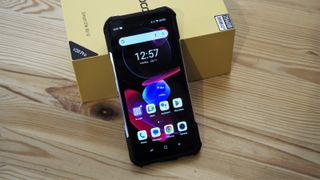
Another feature it inherited from the V20 is the excellent 500 nits, the 6.43" AMOLED FHD+ DotDisplay screen. The colours are punchy, and the blacks are crushed, making video playback look dramatic.
However, the V20 Pro suffers from an issue that we’ve seen on all Doogee branded phones in that it doesn’t support Widevine L1 encryption for video streams, as used by Netflix and Disney+. Because it only supports Widevine L3, the best-streamed resolution from those services and others that use it is 480p, even if the 1080 x 2400 resolution screen could handle much higher resolution content.
Those wishing to get a taste of what this might have been like should watch some high-resolution content on YouTube. For the MSRP of this phone, it should have had L1 encryption, like the Motorola ThinkPhone.
As good a display as OLED can give, the other issue with the display is that it has no textured filter on it, making it less useable in bright sunlight. Considering it’s a rugged phone and likely to be taken outdoors, this seems an obvious oversight.
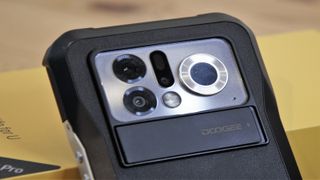
- Hardware score: 4/5
Doogee V20 Pro cameras
- 64MP sensor on the rear
- Macro, night vision and thermal
- Five cameras in total
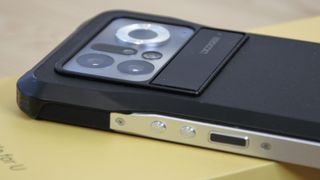
The Doogee V20 Pro has five cameras:
- Rear cameras: 64MP OmniVision OV64B, OmniVision OV24a 24MP night vision, Samsung S5K4H8 8MP wide angle, 256 x 192 Thermal Camera
Front camera: 16MP Samsung S5K3P9 Sensor (Wide)
With so many phone makers using the 108MP Samsung S5KHM2 but not really exploiting that sensor, it seems sensible that Doogee went instead with a 64MP main camera. Except they’re cagy about precisely what that sensor is, but we suspect it’s made by OmniVision, the OV64B.
Alongside that is another OmniVision 24MP sensor, the OV24a, a night vision sensor that uses an infrared light source in the camera cluster to illuminate the dark.
And, an 8MP Samsung sensor provides the wide angle options needed for macro and Bokeh effect images.
On the front is another Samsung sensor, the S5K3P9, that offers 16MP captures for selfies and live video streaming.
All these are fine sensors and the example images attest to the quality that this phone can capture using RAW or classic pixel binning techniques.
This is one of the few rugged phone designs we’ve seen with a full suite of image capture modes that includes HDR, night shoot, slow motion, panorama, time-lapse and full Pro-mode functionality.
However, the video mode has a maximum resolution of 2K when the sensor can achieve 4K, according to the OmniVision specifications. There is also no control over the framerate with video. But what was a real head-scratcher is that the timelapse function doesn’t allow you to control how often pictures are taken, making using it largely potluck.
Therefore, if the 64MP sensor fits your still image requirements, you are in luck, and if you expected anything but basic video, you’re out of it.
But these aren’t the only camera options on this phone. It has the headline act, thermal imaging.
InfiRay makes some excellent thermal sensors either for dedicated cameras or, as in this case inclusion into phones.
A major advantage this phone has over others we’ve seen with thermal imaging is that the thermal sensor and the main camera are relatively close, allowing the images to be presented in a hybrid form.
However, depending on how close the subject it, there is still an offset that the InfiRay software allows you to adjust the overlay to a degree.
On the V20 Pro, the thermal sensor has dedicated software, distinct from the photo capture app. And within that, you can decide how heat is represented, if you have numeric markers for hot and cold spots, and if the main camera image is mixed with the thermal output.
This works well enough, and the responsiveness of the sensor on this phone makes this a much more useable solution than the InfiRay Xinfrared P2 Pro add-on camera that we recently reviewed.
However, we have major reservations about how the specifications of this sensor are being marketed by Doogee and specifically about the quoted resolutions.
Blazoned over the V20 Pro promotional pages on the Doogee website are the claims that this is an improved sensor. It extols that the old one had a 256 x 192 resolution, but this new one is 1440 x 1080. Except when you enter the help part of the InfiRay app that covers the resolution, it declares that it is 256 x 192.
It looks suspiciously like the Doogee marketing department become overly enthusiastic, as the V20 Pro web pages are daubed with all manner of dubious claims and assertions. A personal favourite was ‘Next-Gen 5G Thermal Imaging’, like 5G isn’t currently being used by many phones, and it has anything to do with the Thermal capabilities of this phone.
Perhaps saying that it uses a similar sensor as its 98Pro model and that it is pretty good for what you can get on a phone might have been a more realistic pitch.
Overall, features like thermal imaging are useful to those that need them, and the extra cost beyond the V20 model isn’t prohibitive. But the hype liberally applied to this functionality does nothing for the credibility of this phone maker or the mobile comms industry in general.
Doogee V20 Pro Camera samples











- Camera score: 4/5
Doogee V20 Pro performance
- Efficient CPU and GPU combo
- Lacks Widevine L1
- Modest battery capacity
This is how the Doogee V20 Pro performed in our suite of benchmark tests:
Geekbench: 532 (single-core); 1633 (multi-core); 1494 (OpenCL)
PCMark (Work 3.0): 10102
PCMark Battery: 15h 03m
Passmark: 9299
Passmark CPU: 4622
3DMark Slingshot: 3422(OGL)
3DMark Slingshot Extreme: 2581 (OGL); 2484(Vulkan)
3DMark Wild Life: 1180
If you refer to the V20 review, you’ll notice that the performance of the V20 Pro is practically identical since they use the same SoC. The addition of the extra RAM in the Pro model has had zero impact on its performance, it appears, and it might only do so if you overload it with apps.
The Dimensity 700 provides a reasonable user experience if not especially impressive performance. The GPU on this SoC is underwhelming, making this less than ideal as a gaming device.
What it does do reasonably well is maintain the power efficiency, allowing the smaller capacity battery to offer a workable lifespan for the phone.
We’ve already mentioned it lacks Widevine L1, but we’ll state it again.
Overall, the MediaTek Dimensity 700 is a good platform for an entry-level phone, but this product wouldn’t be classed as that. And, in a ‘Pro’ model, you might expect the Dimensity 900 or even better SoC.
- Performance score: 3.5/5
Doogee V20 Pro battery
- Modest battery size
- 33W Fast charging
- No wireless recharge
By rugged phone standards 6000mAh is modest, if not small.
And, while the efficiency of the Dimensity 700 SoC did allow the V20 Pro to run for 15 hours and 3 minutes on the PCMark battery test, this probably isn’t the phone you might want to take on a week-long hike.
A supposedly strong aspect of this battery is that with 33W fast charging, it is possible to get 16% of the battery capacity back within 30 minutes of attaching it to a charger when almost empty. However, it is also worth pointing out that the AGM G2 specification is for 16W fast charge, but it managed to get 22% of its 7000mAh back in the same time scale. Larger batteries are better for fast charging, but the difference suggests that AGM has superior charging technology.
The big disappointment here is the lack of wireless charging, given the chassis designer had made great efforts to make the underside of this design flat, presumably for that purpose.
- Battery score: 3.5/5
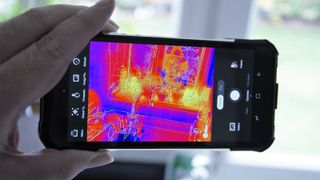
The Doogee V20 Pro is a reasonably predictable design that doesn’t add a huge amount to the 2022 launched V20. However, some of that design was worth keeping.
What it inherited was a modest battery life for a rugged phone, an excellent OLED screen, the Dimensity 700 processor and its Mali-G57 MC2 GPU.
But what it gets on top is 50% more RAM, up from 8GB to 12GB, a genuinely useful kickstand, and thermal imaging.
Our only reservation of the thermal imaging is that Doogee is promoting it as being a resolution that simply doesn’t exist from this sensor supplier, even if the results are decent.
When combined with conventional image capture produces some very useful images, but they’re very similar to any other phone that uses a recent InfiRay 256 x 192 sensor.
But until new better sensors reach the market, this is about as good as it gets on a phone.
If you don’t need thermal imaging, then there are cheaper and more powerful phones on the market than the V20 Pro, and if you just want the phone, the V20 is still available.
Doogee V20 Pro score card
| Attributes | Notes | Rating |
|---|---|---|
| Value | Cheap from some sources for a phone with an OLD screen and thermal imaging. | 4/5 |
| Design | A by-the-numbers button layout, with a neat kickstand and a rubber plug protecting the USB port | 4/5 |
| Hardware | A powerful platform, 5G comms, 108MP camera and thermal sensor | 4/5 |
| Performance | Same performance as the V20, sadly | 3.5/5 |
| Camera | Good quality 64MP stills, but only 2k video and no framerate controls. Thermal imaging isn’t the resolution Doogee suggests. | 4/5 |
| Battery | A modest battery with fast charging but no wireless charging or dock options. | 3.5/5 |
| Overall | Doogee took the V20 and added a little RAM, a thermal sensor and a neat kickstand. Not sure if that makes this phone Pro. | 4/5 |
Should I buy a Doogee V20 Pro?
Buy it if...
You are clumsy
While we’ve not mentioned it much in the review, the V20 Pro can handle being dropped and submersed if you leave the rubber plug in position. While some have widely abused the IP68, IP69K, and MIL-STD-810H labels, the V20 Pro is a robust design that should handle you dropping it once or twice.
You occasionally need thermal imaging
The thermal image camera on the V20 Pro is the latest InfiRay sensor offered on other phones and devices, which can detect a temperature range from -10C to 550C. However, with only a plus or minus 2C accuracy, it has no medical value, and it is more useful to those trying to find failed components on a motherboard or issues with an overheating engine.
Don't buy it if...
You need 4K video
Only being able to capture 2K video might be a deal-breaker for some, as many phones can capture 4K, but not this one. The lack of framerate control on video is disappointing, especially regarding time-lapse captures.
You want longer battery life
While 6000 mAh is a little more than you get in a typical phone, it's small by rugged phone standards. If you intend to hike away for a week without access to mains power and don’t intend to keep turning the phone off, then 6000 mAh might not be enough.
Also consider
UleFone Power Armor 18T
A rugged phone that uses the excellent FLIR 3.5 sensor for thermal imaging and sports the effective Dimensity 900 SoC for an excellent user experience.
It also has 9600 mAh of battery capacity that converts into at least four working days of use or a week of more careful power distribution. And, with 66W charging, it can get 52% of its capacity back in just 30 minutes.
Read our UleFone Power Armor 18T review for more information.
Mark is an expert on 3D printers, drones and phones. He also covers storage, including SSDs, NAS drives and portable hard drives. He started writing in 1986 and has contributed to MicroMart, PC Format, 3D World, among others.

The modular smartphone returns, sort of, as Chinese vendor you've probably never heard of unveils rugged mobile with two surprising accessories

I saw Samsung’s new OLED TV with Glare Free 2.0 tech, and it fixes the Samsung S95D’s biggest problem

I can't decide if I love or hate Halliday Smart Glasses with its ultra-tiny display and nosey AI
